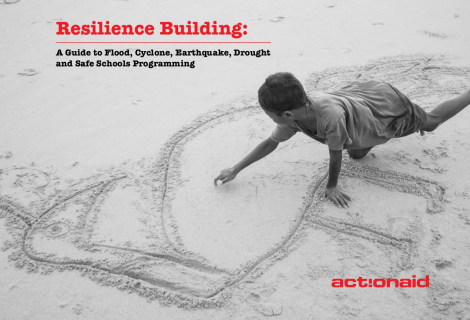
Resilience Building: A guide to flood, cyclone, earthquake, drought and safe schools programming
Disasters, climate change impacts and conflicts affect millions of people every year. They destroy livelihoods and cause huge and often irreversible damage to the economic, social and cultural fabric of communities and nations. The severity of disaster impact is closely associated with inequality, conflict, environmental degradation, badly planned and managed urban development and weak governance. It is often the poor who are forced to stay in marginalised, unstable and disaster prone areas. And it is the economically weak who inhabit the densely populated slums of urban sprawls in developing countries. As people’s vulnerability and exposure to disasters increases, a greater number of people than before are getting affected by disasters like floods, droughts, cyclones and earthquakes.
ActionAid is committed to building the resilience of communities, and different country offices have strategically integrated resilience-building initiatives into their programming and project activities. Most of the organisation’s resilience programming involves building community resilience by implementing projects on Climate Change Adaptation (CCA) and Disaster Risk Reduction (DRR). Apart from these fields of work, ActionAid works with communities globally on various other issues ranging from women’s empowerment and land rights to vocational training, all with smallholder farmers, women, youth and children. Not all of these programmes appear to directly contribute towards resilience. However when their impact on the community is analysed over time, these programmes are seen to be strengthening the capacity of communities through improved livelihoods, empowering communities and groups of people to demand their rights and enabling them to initiate dialogue with government authorities and run campaigns for better living conditions. All these outcomes contribute in one way or another to people’s resilience to disasters or conflicts.
This guidance document is meant to support practitioners working in disaster prone contexts to develop and implement more effective integrated resilience programming. It promotes programming that cuts across different fields of work like rights awareness, food security, emergency preparedness, livelihoods, education, health etc. whilst at the same time encouraging us to work simultaneously at the individual, household, community and national level. It includes specific recommendations for developing resilience programming for communities prone to floods, cyclone, drought and earthquakes. It also includes recommendations to develop safe school programming to help reduce the impact of disasters on school infrastructure, ensure education continuity and build the resilience of students, teachers and their families.